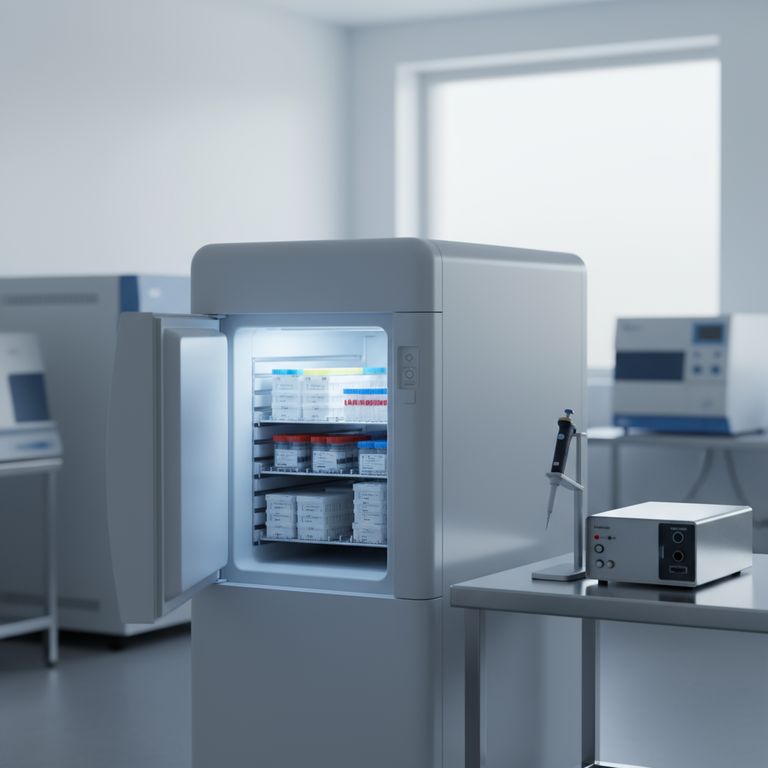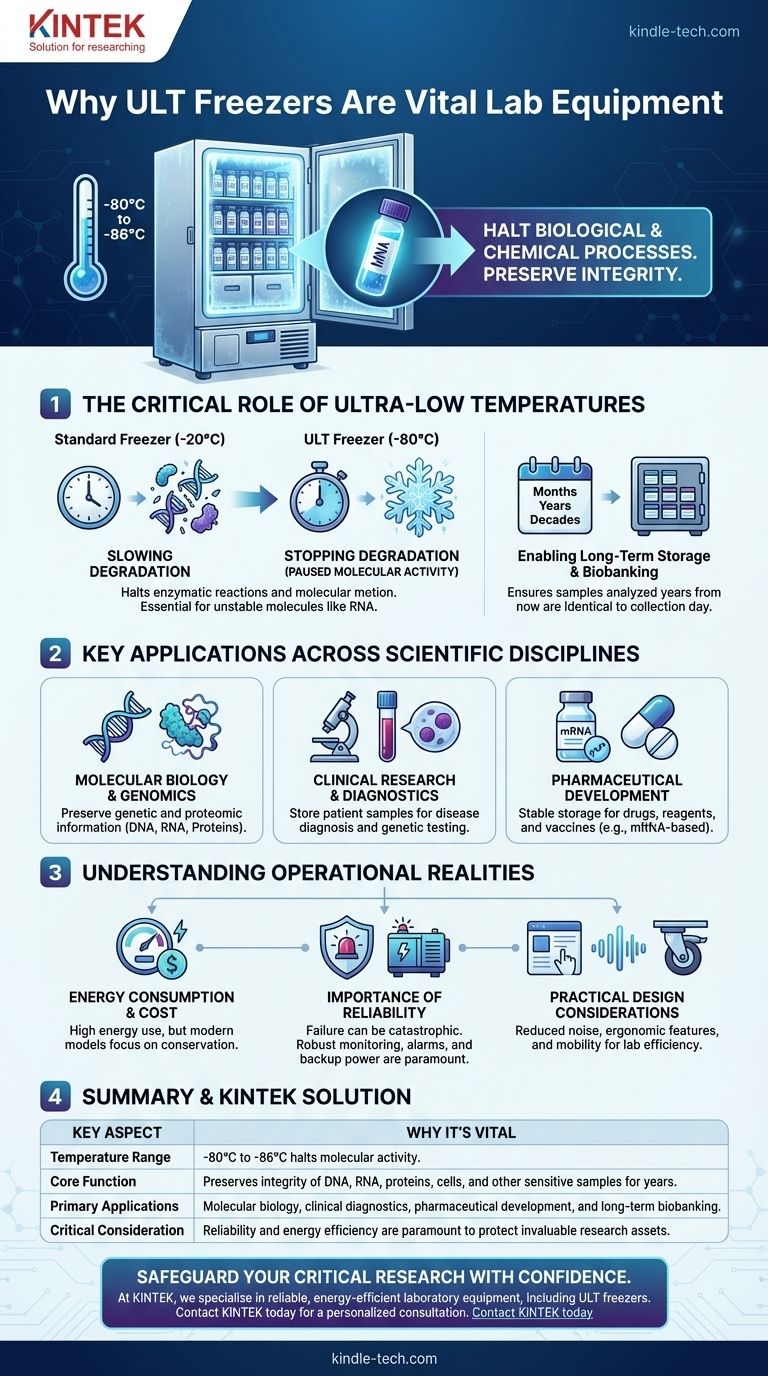At their core, ultra-low temperature (ULT) freezers are vital in laboratories because they create an environment cold enough—typically -80°C to -86°C—to effectively halt the biological and chemical processes that cause sensitive samples to degrade. This level of preservation is impossible in standard freezers and is essential for maintaining the integrity and viability of materials like DNA, RNA, proteins, and cells over long periods.
The fundamental difference between a standard freezer and a ULT freezer is the difference between slowing degradation and stopping it. By virtually pausing all molecular activity, ULT freezers enable the long-term research, biobanking, and diagnostic work that underpins modern life science.

The Critical Role of Ultra-Low Temperatures
To understand why ULT freezers are indispensable, we must look at what happens to biological samples when they are not stored at these extreme temperatures.
Halting Biological and Chemical Degradation
At the temperatures of a household or standard lab freezer (-20°C), many enzymatic and chemical reactions simply slow down. Over time, this activity will degrade critical molecules.
ULT freezers push temperatures to a point where molecular motion is so minimal that these destructive processes effectively cease. This is especially critical for notoriously unstable molecules like RNA, which can be rendered useless for analysis in minutes without proper cold storage.
Enabling Long-Term Storage and Biobanking
This state of suspended animation allows researchers to store samples for months, years, or even decades without significant loss of quality.
This capability is the bedrock of biobanking, where collections of biological specimens are curated for future research. It also makes longitudinal studies—which follow subjects over many years—possible, as samples collected at the beginning of a study remain scientifically valid until its conclusion.
Ensuring Sample Integrity and Viability
The ultimate goal is to ensure that a sample analyzed years from now is identical to the day it was collected. Sample integrity means its molecular composition is unchanged, and viability means that cells or microorganisms are still alive and functional.
ULT storage protects this integrity, ensuring that research data is reliable and that diagnostic tests are accurate. Without it, the results would be based on degraded material, invalidating the entire scientific effort.
Key Applications Across Scientific Disciplines
The need for uncompromising sample preservation makes ULT freezers a cornerstone technology in numerous fields.
Molecular Biology and Genomics
Laboratories studying DNA, RNA, proteins, and cell extracts rely on ULT freezers to prevent enzymatic degradation. This preserves the genetic and proteomic information that is the entire basis of their research.
Clinical Research and Diagnostics
In clinical settings, ULT freezers store a vast array of patient samples, including blood, plasma, serum, and tissue biopsies. These samples are invaluable for diagnosing diseases, conducting genetic testing, and powering research initiatives to find new treatments.
Pharmaceutical Development
The development and storage of many modern drugs, reagents, and vaccines depend on stable, ultra-low temperatures. The global distribution of mRNA-based COVID-19 vaccines, which required ULT storage to maintain their efficacy, is a prime example of their vital role in public health.
Understanding the Operational Realities
While essential, integrating a ULT freezer into a lab involves practical considerations and trade-offs.
Energy Consumption and Cost
ULT freezers are powerful machines that run continuously, making them one of the most energy-intensive pieces of equipment in a lab. Modern models have made significant strides in energy conservation, but their operational cost remains a key factor in lab budgets.
The Importance of Reliability
A freezer failure can be catastrophic, potentially destroying years of irreplaceable work. Therefore, reliability is paramount. Labs depend on robust temperature monitoring systems, alarms, and often, backup power to safeguard their precious assets.
Practical Design Considerations
Beyond pure performance, manufacturers now focus on improving the user experience. Features like reduced noise levels are important for the work environment, while swivel castors provide mobility, allowing for easier lab reconfiguration and maintenance.
Making the Right Choice for Your Goal
Selecting and managing a ULT freezer depends entirely on the materials you need to protect and the nature of your work.
- If your primary focus is long-term biobanking: Prioritize reliability, robust alarm systems, and maximum storage capacity to protect your collection for decades.
- If your primary focus is handling highly sensitive molecules like RNA: Demand a unit with exceptional temperature uniformity and rapid recovery after door openings to prevent even minor degradation events.
- If your primary focus is optimizing a busy lab environment: Consider newer, energy-efficient models with low noise output and ergonomic design features.
Ultimately, the ULT freezer acts as a silent, constant guardian, preserving the biological history that is essential for future scientific discovery.
Summary Table:
| Key Aspect | Why It's Vital |
|---|---|
| Temperature Range | -80°C to -86°C halts molecular activity, stopping degradation instead of just slowing it. |
| Core Function | Preserves integrity of DNA, RNA, proteins, cells, and other sensitive samples for years. |
| Primary Applications | Molecular biology, clinical diagnostics, pharmaceutical development, and long-term biobanking. |
| Critical Consideration | Reliability and energy efficiency are paramount to protect invaluable research assets. |
Safeguard your most critical research samples with confidence. The integrity of your DNA, RNA, cell cultures, and clinical specimens is non-negotiable. At KINTEK, we specialize in providing reliable, energy-efficient laboratory equipment, including ULT freezers, designed to meet the rigorous demands of modern life science research and biobanking.
Let our experts help you select the ideal ultra-low temperature storage solution to protect your work for the long term. Contact KINTEK today for a personalized consultation and ensure your lab's foundation is secure.
Visual Guide

Related Products
- 808L Precision Laboratory Vertical Ultra Low Temperature Freezer
- 108L Vertical Ultra Low Temperature ULT Freezer
- 408L Advanced Vertical Laboratory Ultra Low Temperature Freezer for Critical Research Material Preservation
- 708L Ultra Low Temperature Freezer High Performance Laboratory Freezer
- 208L Advanced Precision Laboratory Ultra Low Temperature Freezer for Cold Storage
People Also Ask
- What are the common designs of ultra-low temperature freezers? Upright vs. Chest Models for Your Lab
- What safety features are commonly found in ultra low temperature freezers? Ensure Sample Integrity with Advanced Protection
- What temperature range do Ultra-Low Temperature freezers maintain? The -80°C Standard for Sample Integrity
- What is the price range for ultra low temperature freezers? Protect Your Samples with the Right Investment
- What makes Ultra-Low Temperature freezers energy efficient? Key Design & Operational Strategies



















